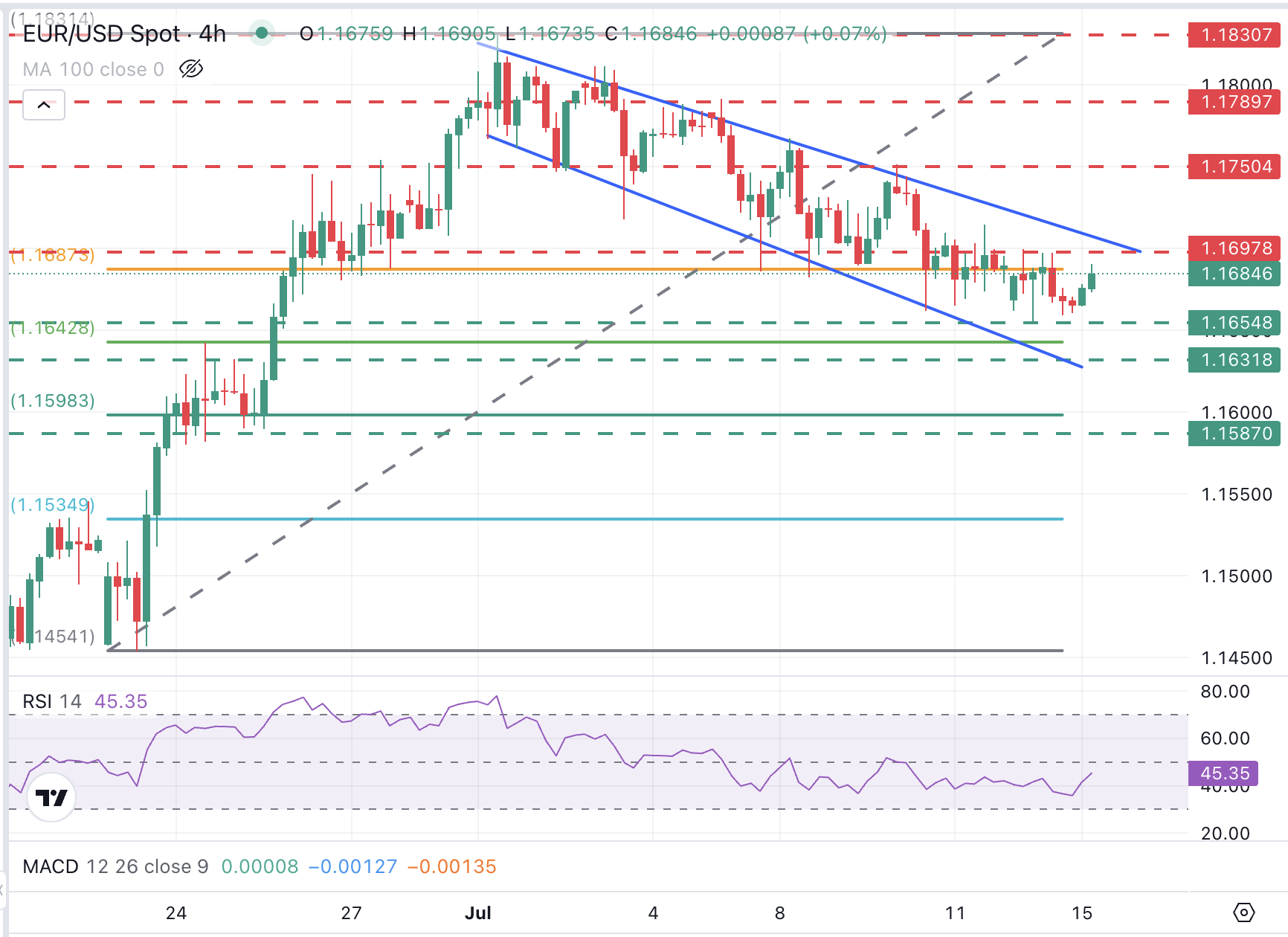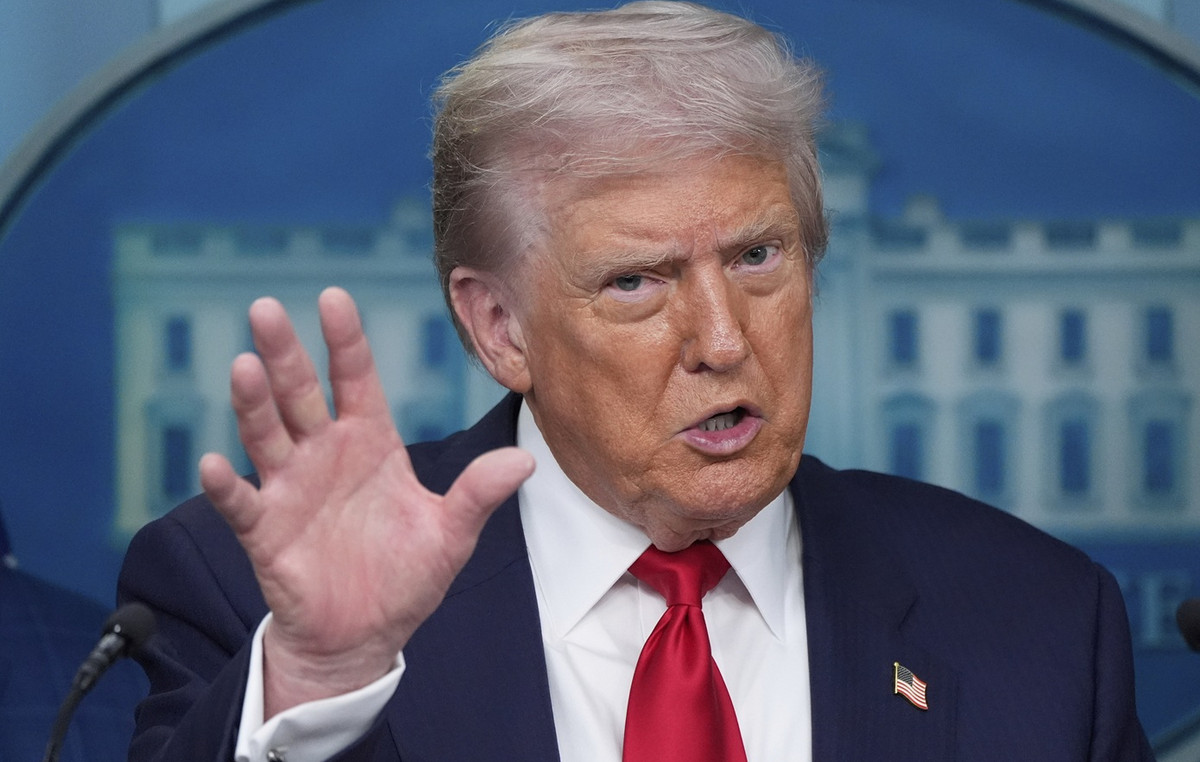- The euro bounces and cuts some of the previous losses as the attention focuses on the publication of the US CPI.
- The hopes of a commercial agreement between the EU and the US and China’s optimistic data are contributing to reducing risk aversion
- The EUR/USD will probably find significant resistance in the 1,1700 area.
The Eur/USD He is quoting up on Tuesday, breaking a loss streak of four days, while representatives of the European Union (EU) and the United States (USA) continue to seek an agreement to avoid a 30% tariff announced by US President Donald Trump, with one eye in the publication of the US consumer price index (CPI).
The euro (EUR) is recovered from the minimum of three weeks in 1,1655 reached on Monday, but remains limited below the level of 1,1700 so far. Observing the widest trend, the pair continues to be trapped inside a bearish channel, going back from a maximum of almost four years of 1,1830 established on July 1.
The market feeling improves something on Tuesday as negotiations with the US continue, and President Trump announced the visit of EU officials to the USA before reiterating his willingness to dialogue in an interview with journalists at the White House on Monday.
The US dollar (USD), on the other hand, shows a somewhat softer tone, with caution investors to maintain large long positions in dollars before the US consumer inflation report. Investors will analyze the June CPI to assess the impact of tariffs and anticipate the next monetary policy steps of the Federal Reserve (Fed). Any deviation from the market consensus could have a significant impact on the crossings of the US dollar.
Meanwhile, US President Trump has continued to press the president of the FED, Jerome Powell, asking for lower interest rates. The unprecedented harassment of Trump will probably intensify if the highest inflation expectations of the Fed do not materialize, questioning the independence of the Central Bank. On previous occasions, these dynamics have increased the negative pressure on the US dollar.
Euro price today
The lower table shows the percentage of euro change (EUR) compared to the main currencies today. Euro was the strongest currency against the US dollar.
| USD | EUR | GBP | JPY | CAD | Aud | NZD | CHF | |
|---|---|---|---|---|---|---|---|---|
| USD | -0.17% | -0.05% | -0.06% | -0.09% | -0.08% | -0.10% | -0.29% | |
| EUR | 0.17% | 0.06% | 0.09% | 0.07% | 0.05% | 0.01% | -0.11% | |
| GBP | 0.05% | -0.06% | 0.00% | 0.00% | -0.04% | -0.08% | -0.02% | |
| JPY | 0.06% | -0.09% | 0.00% | -0.04% | -0.00% | -0.09% | -0.14% | |
| CAD | 0.09% | -0.07% | -0.00% | 0.04% | 0.02% | -0.08% | -0.02% | |
| Aud | 0.08% | -0.05% | 0.04% | 0.00% | -0.02% | -0.05% | -0.03% | |
| NZD | 0.10% | -0.01% | 0.08% | 0.09% | 0.08% | 0.05% | 0.06% | |
| CHF | 0.29% | 0.11% | 0.02% | 0.14% | 0.02% | 0.03% | -0.06% |
The heat map shows the percentage changes of the main currencies. The base currency is selected from the left column, while the contribution currency is selected in the upper row. For example, if you choose the euro of the left column and move along the horizontal line to the US dollar, the percentage change shown in the box will represent the EUR (base)/USD (quotation).
What moves the market today: the US dollar loses strength with the NPC numbers in the focus
- It is expected that US consumer prices have accelerated at a rate of 2.7% year -on -year in June, from 2.4% in May. The underlying CPC is expected to exclude the influence of seasonal food and energy prices, accelerate 3% in the last twelve months to June from 2.8% in the previous month.
- President Trump called President Powell an “idiot, stupid type” on Monday and said inflation is not a serious concern for the economy, stating that interest rates should be reduced to 1%from the current range of 4.25%-4.50%. These attacks will probably intensify if consumer inflation data are below market expectations.
- China’s data revealed that the economy grew at a rate of 5.2% in the second quarter, improving market expectations of a 5.1% reading and reflecting unexpected resistance to US tariffs. These figures have contributed to improving the feeling of the market, adding weight to the US dollar as a safe refuge.
- In the Eurozone, the German ZEW survey is expected to show a modest improvement in the feeling of investors, although at levels still consistent with a weak economic landscape.
- At the same time, Eurostat will publish the industrial production figures of the Eurozone for May, which is expected to show a monthly growth of 0.9%, after the 2.4% contraction observed in April.
The EUR/USD bounces from the minimums, with 1,1700 limiting the increases for now

EUR/USD Continue to quote within a descending channel from the maximum of July 1. The torque is bouncing from the minimums, but the upward attempts will probably remain limited until the perspective of the commercial relationship between the EU and the US is clarified. The technical indicators in the 4 -hour graphic remain in the bearish territory, with the relative force index (RSI) still below the midline of 50.
The bassists failed to confirm below the support area of 1,1660 (minimum of July 10 and 12), but the upward attempts remain limited below 1,1700 so far. A bearish continuation below the aforementioned 1.1660 could find support in 50% Fibonacci of the recent upward rise in the end of June, in 1,1640, before the bottom of the bearish channel from the maximum of July 1, in 1,1630.
Upwards, 1,1700 and the upper part of the channel, now around 1,1710, probably have significant resistance. If that area is broken, the following objective will be the maximum of July 10, in 1,1750.
Tariffs – Frequently Questions
Although tariffs and taxes generate government income to finance public goods and services, they have several distinctions. Tariffs are paid in advance in the entrance port, while taxes are paid at the time of purchase. Taxes are imposed on individual taxpayers and companies, while tariffs are paid by importers.
There are two schools of thought among economists regarding the use of tariffs. While some argue that tariffs are necessary to protect national industries and address commercial imbalances, others see them as a harmful tool that could potentially increase long -term prices and bring to a harmful commercial war by promoting reciprocal tariffs.
During the election campaign for the presidential elections of November 2024, Donald Trump made it clear that he intends to use tariffs to support the US economy. In 2024, Mexico, China and Canada represented 42% of the total US imports in this period, Mexico stood out as the main exporter with 466.6 billion dollars, according to the US Census Office, therefore, Trump wants to focus on these three nations by imposing tariffs. It also plans to use the income generated through tariffs to reduce personal income taxes.
Source: Fx Street
I am Joshua Winder, a senior-level journalist and editor at World Stock Market. I specialize in covering news related to the stock market and economic trends. With more than 8 years of experience in this field, I have become an expert in financial reporting.



.jpg)



